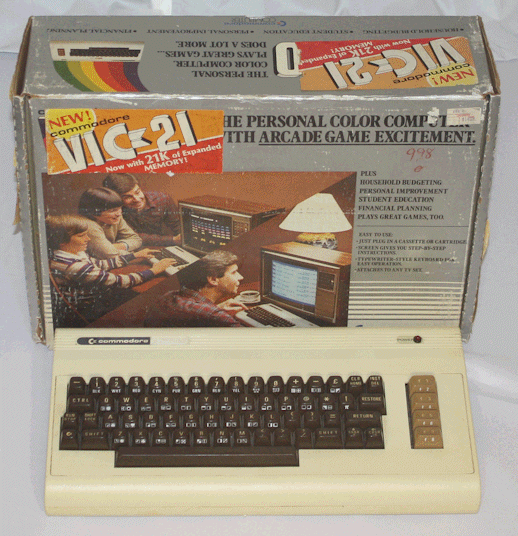

 In 1983, with the popularity of Commodore's breakthrough computer, the
VIC-20 waning,
a retailer decided to pull a neat little trick to help clear those
shelves. By packaging
Commodore's 16k ram expansion pack (VIC-1111) with a VIC-20, Boston retailer Lechmere could
claim to be selling a 21k computer. On this premise, the VIC-20 very
briefly resurfaced as the "VIC-21", also known as the "SuperVIC". This
package amounted to little more than the standard VIC-20 and ram expansion
pack mentioned above. The VIC-20 box was modified with a sticker to make
it appear to be a new product. The computer itself had the words "VIC-20"
cut from the top label.
It appears that this little maneuver was
only pulled on the Boston area before being abandoned.
In 1983, with the popularity of Commodore's breakthrough computer, the
VIC-20 waning,
a retailer decided to pull a neat little trick to help clear those
shelves. By packaging
Commodore's 16k ram expansion pack (VIC-1111) with a VIC-20, Boston retailer Lechmere could
claim to be selling a 21k computer. On this premise, the VIC-20 very
briefly resurfaced as the "VIC-21", also known as the "SuperVIC". This
package amounted to little more than the standard VIC-20 and ram expansion
pack mentioned above. The VIC-20 box was modified with a sticker to make
it appear to be a new product. The computer itself had the words "VIC-20"
cut from the top label.
It appears that this little maneuver was
only pulled on the Boston area before being abandoned.The VIC-21, like all other Commodore 8-bit computers, greets the user with a flashing READY prompt. The operating system is built into the hardware of the computer, and the user interface is BASIC 2.0, a programming language Commodore purchased from Microsoft in the late 1970s. The VIC featured 5 kilobytes of memory, and color graphics at a time when that was very uncommon, though it's display is only capable of 22 characters per line. The joystick port and game cartridge port are prominent features, as Commodore meant to market the VIC as a game console/computer hybrid. The cartridge port could also be used to expand the VIC's memory up to a whopping 28/32 kilobytes.
 ROM: 20 kilobytes
ROM: 20 kilobytes
 Ports: 6522 VIA (X2)
Ports: 6522 VIA (X2)
 Keyboard: Full-sized 66 key QWERTY
Keyboard: Full-sized 66 key QWERTY
 Help: (materials below thanks to Ward Shrake)
Help: (materials below thanks to Ward Shrake)
 Interviews:
Gamer Resources:
Interviews:
Gamer Resources:
Click here to return to the main pictures page
If you find anything in here you have questions or comments about, feel
free to leave me email right here.
To return to my home page, click here.